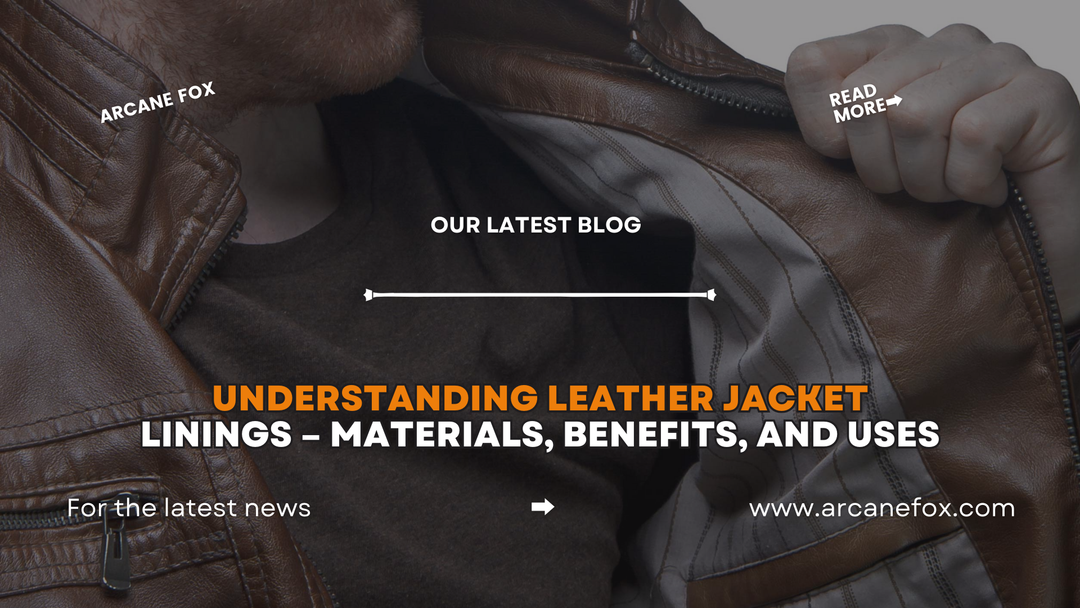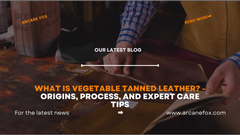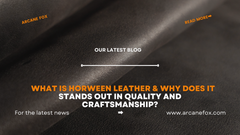Understanding Leather Jacket Linings – Materials, Benefits, and Uses

Understanding Leather Jacket Linings – Materials, Benefits, and Uses
When people think about a jacket, they often picture the outer look. But let’s be real—what’s inside matters just as much. The right leather jacket linings isn’t just fluff; it’s the foundation of comfort, warmth, and durability.
At Arcane Fox, we obsess over the details. From our signature stitching to our choice of premium leather jacket linings, every layer counts. We’ve seen firsthand how the right lining material can make or break the wearability of a jacket.
Whether you're bundling up for winter or grabbing a lightweight layer for spring, the lining fabric plays a key role. It’s not just about warmth—it’s about feel, function, and fit.
Let’s peel back the layers and see what’s really going on inside.
Key Takeaways
- The right jacket lining boosts comfort, regulates temperature, and extends the life of your leather jacket.
- Different lining materials offer unique benefits like warmth, breathability, softness, and structure based on your needs.
- Always match the jacket’s purpose and season with a lining that suits your lifestyle and personal style.
1. What is the Lining of a Leather Jacket?

The lining is the inner layer of a leather jacket, and it does more than you might think. While the leather shell shields you from wind and weather, the lining adds comfort by preventing the leather from rubbing directly against your skin. It also plays a role in regulating temperature—helping you stay warm in winter or cool in warmer months, depending on the fabric used.
Leather jacket linings come in a variety of materials, and each one brings something different to the table. Some are built for warmth, while others focus on breathability. Picking the right lining can really change how a jacket feels, both the moment you put it on and as you wear it throughout the day.
2. The Benefits of Quality leather Jacket Linings

A leather jacket may look bold on the outside, but it’s the inside that quietly does the heavy lifting. A high-quality jacket lining isn’t just a nice bonus—it’s a game-changer for how the jacket feels, fits, and lasts. At Arcane Fox, we handpick lining material that brings out the best in our leather jackets because your comfort matters just as much as your style.
Here’s why the right lining makes all the difference:
- Improved Comfort: A soft, smooth lining—like viscose lining or cotton lining—prevents chafing and feels great against your skin.
- Better Temperature Control: Linings with thermal insulation or moisture-wicking properties help regulate body heat in any season.
- Easy On, Easy Off: Slick materials such as silk lining or taffeta lining make jackets easy to slip into without pulling or bunching.
- Added Structure: A strong lining supports the jacket’s shape and keeps the leather from stretching or sagging over time.
- Longer Lifespan: Quality linings protect the inner leather and stitching, increasing the jacket’s durability and overall wear life.
- Improved Airflow: Materials like breathable fabric or mesh lining allow air to circulate, reducing sweat buildup and discomfort.
- Enhanced Style: Printed or patterned linings—like jacquard fabric or plaid lining—add a personal, stylish touch.
When the inside is made right, you’ll feel it every time you wear the jacket. It’s that quiet luxury—the part only you know about, but it changes everything.
3. Types of Leather Jacket Lining Materials
Not all linings are created equal—and that’s where things get interesting. Each leather jacket lining material brings its own feel, function, and flair. Whether you're dressing for a chilly winter morning or a breezy spring evening, the right lining makes a huge difference.
Let’s break down the most popular types and what they’re best suited for.
3.1 Cotton Lining

Cotton lining is a natural favorite. It's soft, breathable, and feels great on the skin, especially in warmer seasons. This lightweight option helps reduce moisture and prevents the jacket from sticking. While it doesn’t offer much warmth, it’s perfect for comfort and airflow. Think of it as the go-to lining for spring days or mild climates.
- Pros: Breathable fabric, soft texture, non-static.
- Cons: Not insulating, wrinkles easily.
Best for: Spring/summer jackets and everyday casual use.
3.2 Poly-Cotton Lining

Poly-cotton lining blends the best of both worlds. It combines the breathability of cotton with the strength of polyester. This fabric is smooth, doesn’t wrinkle easily, and holds its shape well. It’s a great middle-ground for people who want durability without giving up comfort. Ideal for all-season wear, especially in everyday casual or utility leather jackets.
- Pros: Durable, low-maintenance, wrinkle-resistant.
- Cons: Less breathable than pure cotton.
Best for: Mid-season jackets or light layering pieces.
3.3 Polyester Lining

Polyester lining is tough, shiny, and keeps you warm without piling on bulk. It’s commonly used in puffer jackets and other cold-weather styles because of its excellent ability to trap heat. While it’s not the most breathable, it’s long-lasting and moisture-resistant. Its smooth surface also makes jackets easier to wear and remove, especially in colder conditions.
- Pros: Durability, shine, quick-drying.
- Cons: Less breathable, may retain heat.
Best for: Cold-weather leather jackets and winter layering.
3.4 Nylon Lining

Nylon lining brings strength and durability to the table. It’s built for action, resisting wear and stretching even after years of use. The fabric is slick and adds a polished finish inside. It doesn’t breathe much, but it stands up to tough conditions. Great for rugged outerwear, riding jackets, or any piece that sees daily hustle.
- Pros: Extremely tough, abrasion-resistant.
- Cons: Can trap heat, not as soft.
Best for: Outdoor, utility, or motorcycle jackets.
3.5 Viscose Lining

Viscose lining is like silk’s cooler cousin—soft, shiny, but more budget-friendly. It drapes beautifully and wicks moisture well, making it breathable for year-round comfort. It gives off a premium look while staying practical. Often used in fashion-forward leather jackets, this lining offers a smooth, polished feel without weighing you down.
- Pros: Moisture-wicking, smooth, breathable.
- Cons: Can shrink if not properly cared for.
Best for: All-season jackets and semi-formal outerwear.
3.6 Silk Lining

Silk lining is the definition of elegance. Lightweight and incredibly soft, it’s a treat every time you wear the jacket. Though more delicate than other linings, it offers a refined touch and breathability. It’s hypoallergenic too. You’ll often find it in designer leather jackets or luxury pieces that prioritize comfort and class over rugged durability.
- Pros: Softness, elegance, hypoallergenic.
- Cons: Fragile, costly, limited durability.
Best for: Designer jackets or special occasion wear.
3.7 Taffeta Lining

Taffeta lining adds structure and sheen. It’s crisp to the touch, slightly stiff, and used to give jackets a sharp silhouette. While not the coziest option, it’s ideal for dressy leather jackets or formal wear. Its shiny surface also helps reduce friction. If you’re after a polished interior finish, taffeta gets the job done in style.
- Pros: Smooth, stylish, and shapes well.
- Cons: Less breathable, slightly stiff.
Best for: Formal and structured leather jackets.
3.8 Wool Lining

Wool lining means serious warmth. It’s a natural insulator that breathes, so you don’t overheat while staying toasty. Though it may feel a bit coarse, newer blends make it more skin-friendly. This lining is a staple for winter-ready leather jackets. It brings a vintage, classic vibe while keeping the cold at bay with comfort.
- Pros: Warm, breathable, eco-friendly.
- Cons: Can feel itchy if not blended or softened.
Best for: Heavy-duty winter jackets and vintage-inspired styles.
3.9 Fleece Lining

Fleece lining is a soft, lightweight champion when the temps drop. It traps heat close to the body and feels cozy without adding bulk. Made from synthetic fibers, it dries quickly and resists moisture. While not super breathable, it’s ideal for colder months. Think casual weekend leather jackets made for warmth and ease.
- Pros: Lightweight warmth, quick-drying.
- Cons: Can pill over time, less breathable.
Best for: Fall and winter casual leather jackets.
3.10 Shearling Lining

Shearling lining is top-tier warmth wrapped in luxury. Real sheepskin with the wool attached keeps you cozy even in icy weather. It’s soft, naturally breathable, and incredibly stylish. The downside? It adds weight and cost—but it's worth every penny. Perfect for winter leather jackets, aviators, and rugged outerwear with a premium edge.
- Pros: Exceptional warmth, long-lasting, unique texture.
- Cons: Expensive, heavier.
Best for: Winter wear, aviator and bomber jackets.
3.11 Sherpa Lining

Sherpa lining gives you that plush, fuzzy feel—without using animal products. It looks and feels like real wool but is made from soft synthetics. While it doesn’t match the longevity of shearling, it delivers comfort and warmth with a cruelty-free approach. Ideal for everyday leather jackets with a laid-back, cozy vibe.
- Pros: Soft, warm, animal-free.
- Cons: Less durable than real shearling.
Best for: Ethical winter sheepskin jackets, casual outerwear.
3.12 Faux Fur Lining

Faux fur lining is fashion-forward and warm, all while being 100% synthetic. It mimics the plush softness of real fur but without harming animals. Though it can feel heavy and a bit warm for mild climates, it’s perfect for winter wear. This lining is a bold, stylish statement for those who love luxury and ethics combined.
- Pros: Stylish, warm, cruelty-free.
- Cons: Bulky, may not breathe well.
Best for: Statement fur leather jackets and cold-weather fashion.
4. Matching Lining Material with Leather Jacket Styles

Not every type of leather jacket is built for the same purpose—and neither is every lining material.
Pairing the right lining with the right jacket style makes a big difference in comfort, function, and feel. At Arcane Fox, we take this match seriously because we know a perfect fit starts from the inside.
A bomber and aviator jacket with a shearling lining is a winter staple—warm, rugged, and timeless. For biker jackets, nylon or polyester lining adds durability and lets you move freely while keeping wind at bay.
If you're after something lightweight and breathable, a cotton lining works great inside suede leather jackets, especially during spring or fall.
Puffer leather jackets often feature quilted lining or fleece lining to trap body heat without adding too much bulk—ideal for active, cold-weather wear. In contrast, sheepskin jackets usually come with their own natural wool lining or shearling lining, making them unbeatable for deep winter warmth.
For sleek, dressy styles like tailored leather coats or minimal bombers, opt for taffeta, silk, or viscose lining—all smooth, breathable, and elegant. Whether you're layering for warmth or dressing for style, choosing the right lining enhances both the look and the experience of wearing the jacket.
5. How to Choose the Right Lining for Your Needs?

Choosing the perfect leather jacket lining material isn’t just about trends—it’s about how that jacket feels, wears, and supports your day-to-day life. At Arcane Fox, we believe lining decisions should balance comfort, function, and personal style. These practical tips will help guide you toward a jacket that fits your lifestyle as well as it fits your frame.
5.1 Consult with a Professional
If you're unsure where to start, don’t hesitate to speak with a leatherwear expert. A quick consultation can help narrow down the best fabric for leather jacket lining based on your climate, wear frequency, and comfort needs. A pro’s insight makes the decision faster—and smarter.
5.2 Think About How You’ll Use the Jacket
Will this be your go-to riding jacket? Or a casual throw-on for coffee runs? Your intended use matters. A leather jacket with lining built for movement, warmth, or breathability will feel completely different depending on your activity level and environment.
5.3 Budget with Intention
Working within a budget? Go for practical options like polyester lining or cotton lining. These offer quality without overextending your wallet. While silk lining and satin feel luxe, cost-effective choices can still bring comfort and style—especially when designed right.
5.4 Honor Your Personal Style
Your lining fabric should reflect your personality just as much as your jacket’s cut. Whether you lean minimalist, rugged, or bold, there’s a lining that fits. Some prefer smooth viscose, others love plush Sherpa—the key is finding what feels right inside and out.
5.5 Touch Before You Commit
Before locking in your jacket, ask to feel a swatch or test the lining material. See how it drapes, how it reacts to movement, and how it sits against your skin. That little test ensures your final jacket meets your expectations every time you wear it.
In the end, selecting the right lining is part comfort, part common sense, and part self-expression. It’s not just about warmth—it’s about finding a jacket that feels like it was made for your life. And at Arcane Fox, we believe the perfect lining does exactly that.
6. How to Maintain Leather Jacket Linings?

As mentioned earlier, choosing a compatible outer shell and lining material is important for easy upkeep. If you're buying a ready-to-wear jacket, always check the care label. It provides basic maintenance tips for both the leather exterior and the inner lining to help keep your jacket in great condition.
6.1 Cleaning Leather Jacket Lining
Since the lining sits close to your skin, it absorbs sweat, oils, and body moisture over time, so occasional cleaning is essential. The safest method is to bring your jacket to a professional leather cleaner. Because the lining is sewn into the jacket, it can’t be washed like ordinary clothing.
To clean it yourself, turn the jacket inside out. Mix a gentle detergent with water, dip a soft microfiber cloth into the solution, and wring it out well. Gently wipe the lining, focusing on any stained spots. Rinse out the cloth, remove any leftover soap, and wipe again. Hang your jacket inside out to air dry completely.
6.2 Replacing Leather Jacket Lining
If your lining is worn out, stained beyond saving, or damaged, there’s no need to toss the entire jacket—you can simply have it relined. Avoid doing it yourself, as poor stitching can distort the jacket’s shape. Instead, take it to a skilled tailor or leather specialist to ensure it gets a neat and professional update.
Read More: How to Clean a Leather Jacket Without Damaging It?
7. Final Thoughts
A great leather jacket isn’t just about the outer shell—it’s also about what’s inside. The right lining material affects comfort, warmth, breathability, and how the jacket fits your lifestyle.
At Arcane Fox, we treat the lining like the heart of the jacket. From cotton lining for lightweight wear to shearling lining for serious cold, we match each style with the right inner fabric to keep you comfortable and confident.
So whether you’re dressing up or layering down, the lining you choose makes all the difference. It’s the quiet detail that elevates every wear into something exceptional.
Related Posts:





